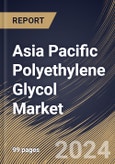The China market dominated the Asia Pacific Polyethylene Glycol Market, By Country in 2022, and would continue to be a dominant market till 2030; thereby, achieving a market value of $997.6 million by 2030. The Japan market is experiencing a CAGR of 5.7% during (2023 - 2030). Additionally, The India market would exhibit a CAGR of 6.4% during (2023 - 2030).
The market is a multifaceted landscape characterized by its widespread adoption, diverse applications, and constant evolution driven by innovative trends. Polyethylene glycol, a versatile polymer with varying molecular weights, has found its way into many industries, playing a pivotal role in shaping modern technological advancements and consumer products. It has witnessed a remarkable surge in adoption across diverse industries, owing to its unique properties and versatility. This polymer, derived from ethylene oxide, is characterized by its water solubility, low toxicity, and compatibility with various substances. These inherent characteristics make polyethylene glycol a sought-after compound in pharmaceuticals, personal care products, industrial applications, and more.
Furthermore, the industrial sector has embraced polyethylene glycol for applications ranging from lubricants and antifreeze formulations to metal processing and as a de-icing agent. As per the data provided by the State Council of China, in July 2023, annual growth was 3.7% for the total value added by industrial enterprises exceeding the designated size. The manufacturing value added of basic materials increased by 8.8 percent annually. Likewise, as per Eurostat, the industrial output of the European Union increased by 8% between 2020 and 2021, and this upward trend persisted in 2022 with a 5% increase relative to 2021. In nominal terms, in 2022, the EU’s value of sold production jumped from €5 209 billion in 2021 to €6 179 billion in 2022, an increase of 19 %.
Moreover, in Australia, the rising demand in the healthcare sector has led to an expansion in polyethylene glycol (PEG) use. It is a versatile compound with various applications in the healthcare industry, particularly in pharmaceuticals and medical devices. As per the data from the Government of Australia, the country spent an estimated $241.3 billion on health goods and services in 2021-22 - an average of approximately $9,365 per person. The real growth (adjusted for inflation) in total health spending (recurrent and capital) was 6.0% more than in 2020-21. This was higher than the average yearly growth rate over the decade to 2021-22 (3.4%). Therefore, the growing healthcare sector in Asia Pacific will assist in the expansion of the regional market.
Based on Application, the market is segmented into Medical, Personal Care, Industrial, and Others. Based on countries, the market is segmented into China, Japan, India, South Korea, Singapore, Malaysia, and Rest of Asia Pacific.
List of Key Companies Profiled
- BASF SE
- The Dow Chemical Company
- LOTTE Chemical Corporation (LOTTE Corp.)
- INEOS Group Holdings S.A. (INEOS Oligomers)
- Croda International PLC
- India Glycols Limited
- Liaoning Oxiranchem Inc.
- Liaoning Kelong Fine Chemical Co., Ltd.
- Jiangsu Hai'an Petrochemical Plant
- Shanghai Bronkow Chemical Co. Ltd.
Market Report Segmentation
By Application (Volume, Kilo Tonnes, USD Billion, 2019-2030)- Medical
- Personal Care
- Industrial
- Others
- China
- Japan
- India
- South Korea
- Singapore
- Malaysia
- Rest of Asia Pacific
Table of Contents
Companies Mentioned
- BASF SE
- The Dow Chemical Company
- LOTTE Chemical Corporation (LOTTE Corp.)
- INEOS Group Holdings S.A. (INEOS Oligomers)
- Croda International PLC
- India Glycols Limited
- Liaoning Oxiranchem Inc.
- Liaoning Kelong Fine Chemical Co., Ltd.
- Jiangsu Hai'an Petrochemical Plant
- Shanghai Bronkow Chemical Co. Ltd.
Methodology

LOADING...








